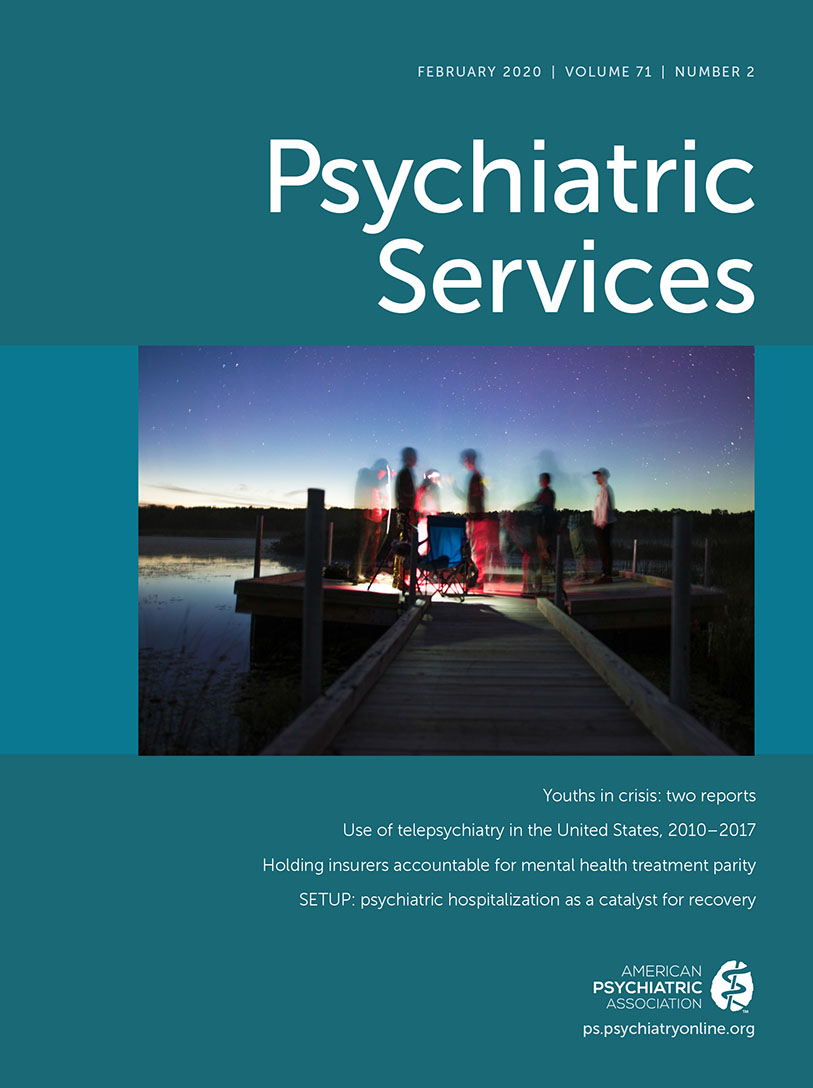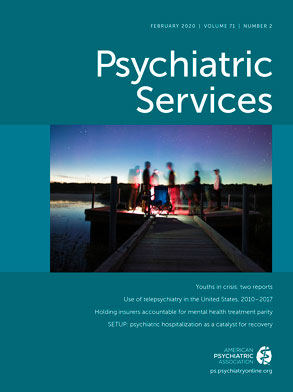In 2013, Natasha Wit, then 17 years old, was admitted to Monte Nido Vista, a residential treatment facility in California for women with eating disorders. At the time, she was said to be suffering from a severe eating disorder, with medical complications that included amenorrhea, adrenal and thyroid problems, vitamin deficiency, and gastrointestinal symptoms. She was also reported to be experiencing symptoms of depression and anxiety, obsessive-compulsive behaviors, and marked social isolation. Four days after admission, her insurer, United Behavioral Health (UBH), denied coverage for her stay on the basis that her “treatment does not meet the medical necessity criteria for residential mental health treatment per UBH Level of Care Guidelines for Residential Mental Health.” The reviewer suggested that she could safely be treated at a less restrictive level of care (
1).
Ms. Wit’s difficulty in obtaining coverage from her health insurer for care that she and her treaters believed was medically necessary differed in only one respect from the similar experiences of thousands of patients around the country: her family was able to pay for the 2 months of residential treatment that UBH refused to cover. Max Tillitt, a 21-year-old man with a heroin addiction, was not so fortunate. When UBH refused a request to authorize continued care after his first 3 weeks in a residential treatment program for addictions—and denied the facility’s urgent appeal of the decision—he was discharged and died of a drug overdose 10 weeks later (
2). Attempting to recover the costs of the denied treatment and to alter UBH’s decision-making procedures, the Wits helped to initiate a class action lawsuit against UBH and were later joined by other plaintiffs, including Linda Tillitt, Max’s mother. They claimed that UBH had violated its fiduciary obligations and arbitrarily denied them benefits due under the federal Employee Retirement Income Security Act (ERISA).
Legal Background: MHPAEA, ERISA, and the Fight for Parity
The struggle for fairness in coverage of mental health treatment by health insurers has focused on gaining parity with coverage of general medical conditions. During the period of explosive growth in health insurance after World War II, policies often excluded mental health care entirely or established arbitrary limits on its utilization. Plans that offered any mental health benefits would typically cover a fixed number of outpatient visits or hospital days, in contrast with coverage of general medical conditions, which often was unlimited (
3). Although some states took steps to require a modicum of mental health coverage in policies, a major obstacle was that federal law, specifically ERISA, prevented state regulation of self-insured employer plans, which covered tens of millions of workers (
4).
An early move toward more comprehensive regulation was taken in 1996, when Congress passed the Mental Health Parity Act (MHPA) (
5). It prevented employer-sponsored plans from imposing differential annual or lifetime dollar limits on mental health care compared with general medical care. However, it did not prohibit limits on the number of treatment sessions, higher copays, or more rigorous authorization requirements for mental health services (
5). Nor, perhaps most importantly, did the MHPA require any coverage of mental health treatment in the first place.
Further progress was made in 2008, when the Mental Health Parity and Addiction Equity Act (MHPAEA) was passed into law. It applied to more types of health plans, covered substance abuse treatment in addition to other mental health conditions, and banned differential rules regarding treatment limits, copays and deductibles, out-of-network coverage, and prior authorization and utilization review. The most recent step toward comprehensive regulation was the passage of the Affordable Care Act (ACA), the first federal law to require coverage of mental and substance use disorders (
5).
Although evidence suggests that the MHPAEA and the ACA led to better access to mental health treatment and increased utilization (
6), the promise of parity with general medical care remains unfulfilled. For example, patients’ ongoing litigation to obtain coverage for mental health treatment has particularly focused on access to residential treatment facilities and medical necessity determinations (
7). Another indication of the enduring problems comes from the federal Employee Benefits Security Administration, which carries a large share of responsibility for enforcing the MHPAEA. Almost 50% of their enforcement actions relate to “nonquantitative treatment limitations,” including overly stringent medical necessity criteria (
8). However, challenging such policies under the MHPAEA is difficult because plaintiffs must prove a discrepancy between procedures for review of general medical claims and mental health claims—an inherently problematic apples-to-oranges comparison. Thus, litigators looking to challenge insurers’ practices have turned to bringing actions under ERISA (
9), which is exactly what the Wits did.
Under ERISA, a 1974 federal statute that regulates employee benefits, health insurers and plan administrators are considered to be fiduciaries, a legal term that generally signifies a person or entity in a position of power, obligated to act solely in the interest of a third party. An ERISA fiduciary “shall discharge his duties with respect to a plan solely in the interest of the participants and beneficiaries and for the exclusive purpose of: (i) providing benefits to participants and their beneficiaries” (
10). Any beneficiary of an ERISA-covered plan can bring a civil action alleging that a fiduciary has failed to live up to this responsibility. Remedies include enjoining the fiduciary from continuing to ignore its legal obligations and obtaining compensation for benefits that were improperly denied. However, ERISA does not permit recovery of damages for harms suffered as a result of improper benefit denials or punitive damages.
Suing UBH
In bringing their class action suit on behalf of themselves and all similarly situated persons insured by UBH, the Wits argued that the company had failed to live up to its statutory responsibilities as a fiduciary by pursuing its own financial interests rather than the interests of its insureds. Their claim was in large part based on the discrepancies between UBH’s various guidelines for making coverage determinations and professional standards of care for mental and substance use disorders.
One example of the alleged shortcomings was the focus of the UBH guidelines on addressing immediate symptoms. The guidelines required “a reasonable expectation that essential and appropriate services will improve the member’s presenting problems within a reasonable period of time” for the services to be covered. Further, improvement was defined in another document as “the reduction or control of the acute symptoms that necessitated hospitalization or residential treatment.” Once that degree of improvement had been achieved, the UBH documents suggested that coverage would be terminated: “The goal of treatment is to improve the member’s presenting symptoms to the point that treatment in the current level of care is no longer required.” But this focus exclusively on acute symptoms appears inconsistent with professional standards that recognize the chronicity of many mental and substance use disorders and that emphasize the goals of long-term stabilization and preventing relapse. For example, guidelines issued by the American Society of Addiction Medicine (ASAM) note that “addiction treatment services have as their goal not simply stabilizing the patient’s condition but altering the course of the patient’s disease toward wellness.” One of the Wits’ experts, Dr. Eric Plakun, analogized chronic mental disorders to a pot of water over a flame: “It’s optimal to try to find a way to turn the flame down and not simply feed the recurrent loop of crisis.”
The case was tried in federal district court in San Francisco before a chief federal magistrate judge, Joseph Spero. (Magistrates can rule in civil litigation with the consent of the parties.) His 106-page opinion (
11), issued in March 2019, was notable in several ways. He identified a set of published guidelines from professional societies that he ruled reflected accepted standards of care, including several of the American Psychiatric Association’s practice guidelines, ASAM care criteria, and guidelines from the American Association of Community Psychiatrists, the American Academy of Child and Adolescent Psychiatry, and the federal Medicare program. He also explicitly determined the credibility of the witnesses in the case, finding the plaintiffs’ experts credible, but identifying problems with the credibility of each of UBH’s witnesses, in some cases all but suggesting deliberate falsification.
Moreover, from his review of the published guidelines, Judge Spero identified eight principles that constituted accepted standards of care (
11) (
Box 1). In each instance, Judge Spero found that UBH’s guidelines for coverage were inconsistent with generally accepted standards, for example, because they focused excessively on treatment of acute symptoms rather than either long-term improvement or prevention of deterioration and maintenance of existing function, and because they judged children’s needs according to adult criteria. In addition, he pointed to evidence from internal UBH documents that indicated the company had been guided by financial considerations rather than the needs of its insureds in developing its restrictive criteria.
Next Steps
The decision in
Wit v. UBH was hailed in mental health circles as an important rebuff to insurers’ use of restrictive review criteria to deny meaningful parity in mental health coverage. For example, the Medical Director Institute of the National Council for Behavioral Health endorsed the eight principles identified by the court and suggested in addition that greater transparency and greater emphasis on co-occurring conditions were needed in the development of insurers’ review criteria. In holding that the largest health insurer in the United States knowingly failed to conform to accepted standards of treatment, the opinion in
Wit constitutes a stunning repudiation of the industry. But the litigation is not complete. In the next phase, to be reimbursed for their care, the named plaintiffs will have to demonstrate that each of them failed to receive appropriate coverage from UBH. The plaintiffs will have the opportunity to suggest remedies that the court could adopt to ensure that UBH develops guidelines consistent with accepted standards and applies them appropriately in future coverage determinations. Subsequently, UBH will have the opportunity to appeal the judgment (
12).
Notwithstanding the litigation still to come, Wit v. UBH represents the most successful effort to date to hold insurers accountable for actions that result in unequal coverage for mental and substance use disorders. Judge Spero’s decision could serve as a model for other plaintiffs trying to make the promise of parity a reality.

